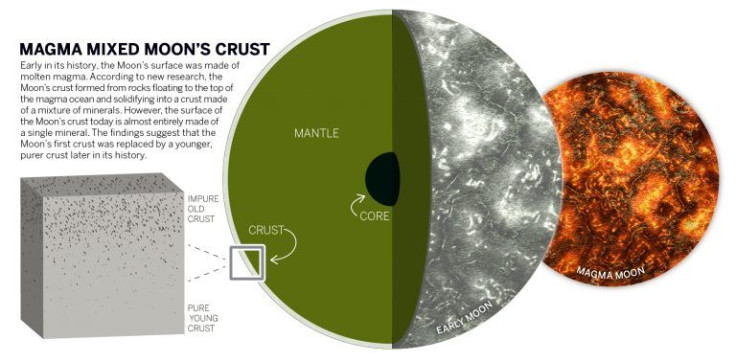Moon's Magma Ocean Purified Lunar Crust Through 'Crustal Overturn': Study

The Moon has been our celestial companion for the longest time. This glowing orb in the night sky has fascinated humans for as we long as we can remember. It is common knowledge that the Moon split from Earth and our visits there have given us a vivid picture of what it is made of and how it came into being. Now a team of researchers from The University of Texas at Austin Jackson School of Geosciences have made some revelations about our satellite’s grey crust.
The team were recreating the magmatic melt that once covered the entire surface of the Moon, before it cooled and formed its current crust. The team found that the rocky surface we see today initially formed because rock from cooler section of the magma ocean rose to the surface. The study uncovered a theory that could explain a long existing question that has surrounded the Moon’s surface and how the crust is made up of just one mineral.
Nobody has been able to explain the lack of diversity in the minerals found on the crust because the Moon split from Earth, which has a rich mineral diversity, until now. The team says that this single mineral surface cannot be explained by the initial crust formation and must have been the result of some secondary event.
This mineral — plagioclase — is the primary mineral found in Moon’s crust. An estimated 98 percent of the lunar surface is made of this mineral alone. Current theories say that this is due to plagioclase floating to the surface of the magma ocean over hundreds of millions of years and solidifying into the Moon’s crust. This theory assumes that the magma ocean had a specific viscosity that would allow only the plagioclase to separate from other dense minerals crystallized in the magma.
According to a press release on The University of Texas at Austin Jackson School of Geosciences, Nick Dygert, an assistant professor at the University of Tennessee, Knoxville, led the research and his team performed the experiment which involved "recreating the molten material in the lab by flash melting mineral powders in Moon-like proportions in a high pressure apparatus at a synchrotron facility, a machine that shoots out a concentrated beam of high energy X-rays, and then measuring the time it took for a melt-resistant sphere to sink through the magma."
The results of the study were published on Nov. 21 in the Journal for Geophysical Research: Planets.

The results showed the team that the magma melt had a very low viscosity, somewhere between that of olive oil and corn syrup at room temperature. This value was found to be coherent with the past theory of the plagioclase floating to the surface. This low viscosity also led to mixing of plagioclase with the magma causing other crystallized minerals to get trapped in the pure plagioclase crystals. We know that the lunar surface is almost pure plagioclase.
The team suggested a secondary process that must have led to this. Dygert said in the release that the results support a "crustal overturn" on the lunar surface where the old mixed crust was replaced with young, buoyant, hot deposits of pure plagioclase. The older crust could have also been eroded away by asteroids slamming into the Moon’s surface.
This cyclic refreshment of the lunar surface with new, pure plagioclase explains the 98% pure measurements on the Moon.
"Previously, there had not been any laboratory data to support models," said Jackson School Associate Professor Jung-Fu Lin, who was a part of the team. "So this is really the first time we have reliable laboratory experimental results to understand how the Moon’s crust and interior formed."
Dygert said the study’s results add to the credibility of small-scale experiments and shows that they can lead to large-scale understanding of geological processes that build planetary bodies in our universe.
"I view the Moon as a planetary lab," Dygert added in the release. "It’s so small that it cooled quickly, and there’s no atmosphere or plate tectonics to wipe out the earliest processes of planetary evolution. The concepts described here could be applicable to just about any planet."
© Copyright IBTimes 2024. All rights reserved.





















